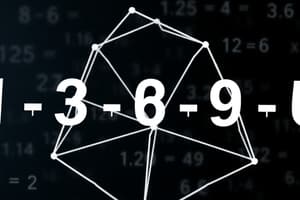Podcast
Questions and Answers
What is a key component of a mathematical system?
What is a key component of a mathematical system?
- Proofs
- Theorems
- Axioms
- Vocabulary (correct)
What is the purpose of symbols in a mathematical system?
What is the purpose of symbols in a mathematical system?
- To establish postulates
- To represent complex ideas (correct)
- To prove theorems
- To define new terms
Which of the following is an example of an undefined term in a geometrical system?
Which of the following is an example of an undefined term in a geometrical system?
- Angle
- Point (correct)
- Triangle
- Parallel line
What is the primary purpose of definitions in a mathematical system?
What is the primary purpose of definitions in a mathematical system?
Which of the following is not a component of a mathematical system?
Which of the following is not a component of a mathematical system?
Which of the following is a common geometrical symbol?
Which of the following is a common geometrical symbol?
Which of the following is not considered a key concept in a geometric mathematical system?
Which of the following is not considered a key concept in a geometric mathematical system?
What is the primary purpose of studying geometrical properties and relationships?
What is the primary purpose of studying geometrical properties and relationships?
Which of the following is not considered a substantive branch of mathematics?
Which of the following is not considered a substantive branch of mathematics?
What is the main purpose of postulates in a mathematical system?
What is the main purpose of postulates in a mathematical system?
How do theorems differ from postulates in a mathematical system?
How do theorems differ from postulates in a mathematical system?
Flashcards are hidden until you start studying
Study Notes
Mathematical Systems and Geometry
Since the dawn of humanity, humans have sought ways to understand the world around them. One of the most powerful tools in achieving this goal has been the study of mathematics, a discipline encompassing a wide range of subjects, including geometry. In this article, we will delve into the concept of mathematical systems, focusing particularly on the area of geometry.
Understanding Mathematical Systems
A mathematical system is composed of four main elements: vocabulary, definitions, principles (including postulates and theorems), and symbols. Each of these components contributes to the structure and understanding of the mathematical concepts within the system.
Vocabulary and Symbols
The vocabulary of a mathematical system includes both undefined and defined terms. Undefined terms are essentially building blocks, such as point, line, and plane, which cannot be further broken down into simpler concepts. Defined terms, on the other hand, are explained using existing vocabulary and are given specific meanings within the system.
Symbols are representations of concepts within the system. They allow for efficient communication and simplification of complex ideas. Common geometrical symbols include those for triangles, angles, lines, and points, among others.
Definitions
Definitions provide clarity and structure by assigning specific meanings to terms within the system. The four characteristics of a good definition are: it names the term being defined, places it into a category, distinguishes itself from other terms in that category, and is reversible.
Principles
Principles encompass both postulates and theorems. Postulates are statements assumed to be true without requiring proof. They form the foundation upon which more complex mathematical structures can be built. Theorems follow logically from the principles and definitions established within the system, and their truth can be demonstrated through proofs.
Geometry within Mathematical Systems
Geometry is one of the substantive branches of mathematics, alongside algebra, analysis, number theory, statistics, optimization, and trigonometry, among others. It deals with the study of shapes, sizes, positions, and spatial relationships. Within a geometric mathematical system, there are several key concepts to consider:
- Points: These serve as locations in space from which measurements can be taken.
- Lines: Lines define distance and direction between two points.
- Angles: Angles describe the rotation between intersecting lines.
- Triangles: Triangles consist of three line segments connected at vertices, forming closed loops.
- Planes: Planes represent flat surfaces extending infinitely in all directions.
The Role of Geometry in Mathematical Systems
The importance of geometry lies in its ability to provide a framework for understanding various aspects of our world. By studying geometrical properties and relationships, we can make predictions about the physical environment and develop models that help us comprehend complex phenomena. This branch of mathematics has played a crucial role in fields such as engineering, physics, computer graphics, and architecture, ensuring its continued relevance and significance.
Studying That Suits You
Use AI to generate personalized quizzes and flashcards to suit your learning preferences.




